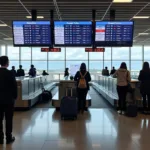The quest to identify the world’s 1st International Airport is a fascinating journey through aviation history. While pinpointing the absolute “first” is complex due to evolving definitions of “international,” we can explore early airports that pioneered international travel and laid the groundwork for today’s global network. This article delves into the history, challenges, and innovations surrounding the emergence of international air travel and the airports that facilitated it.
Early Pioneers of International Flight: Contenders for the 1st International Airport Title
Before the formal designation of “international airports,” several airfields facilitated cross-border flights. These early pioneers played crucial roles in shaping the future of aviation and international travel. Determining the definitive “1st international airport” is challenging due to varied criteria and evolving definitions. However, several key contenders emerge in the early days of aviation. These airports were instrumental in establishing international air routes and developing the infrastructure necessary for global air travel.
College Park Airport: A Historic Contender
Established in 1909, College Park Airport in Maryland, USA, boasts a rich history, serving as a training ground for early aviators. While not explicitly designated as “international” in its early years, its historical significance in the development of aviation contributes to its consideration.
Considering Europe’s Early Airports
Across the Atlantic, several European airports emerged as vital hubs for international travel. Airfields in Paris, London, and Berlin played key roles in connecting European nations. While records may be incomplete, these airports were instrumental in establishing early international air routes.
The Evolution of “International”: Defining the 1st International Airport
The concept of an “international airport” evolved alongside advancements in aircraft technology and increasing demand for cross-border travel. Early international flights were often ad-hoc, lacking standardized procedures and dedicated infrastructure. The development of customs and immigration processes, along with the establishment of international agreements, solidified the concept of the international airport as we know it today. Similar to [1st airport in india], these early airports faced challenges related to navigation, communication, and passenger processing.
The Role of International Agreements
The establishment of international aviation agreements played a critical role in defining and regulating international air travel. These agreements established standards for safety, navigation, and airport operations, facilitating the growth of a truly global network. The standardization of procedures and infrastructure cemented the role of designated international airports. Understanding the evolution of these agreements helps contextualize the challenges and triumphs of early international airports. The growth of [abudhabi airport 1st to 3rd terminal] illustrates how international airports adapt to increasing passenger volume and evolving needs.
Key Features of 1st International Airports
While the precise features varied, early international airports shared some common characteristics: customs and immigration facilities, basic passenger terminals, and runways capable of handling larger aircraft. These nascent features laid the groundwork for the complex and sophisticated international airports we know today. They represent the beginning of a globalized aviation network. For a deeper understanding, explore the development of [1st hartsfield-jackson atlanta international airport].
Navigational and Communication Challenges
Early international flights faced significant navigational and communication challenges. Pilots relied on rudimentary maps and limited radio communication. The development of more sophisticated navigational aids and communication systems was crucial for the safe and efficient expansion of international air travel. The challenges faced by early international airports are reminiscent of the issues encountered at [1st airport rd pago pago as 96799].
Conclusion: A Legacy of Innovation
While identifying the absolute 1st international airport remains a complex historical question, exploring the early pioneers of international flight reveals a legacy of innovation and determination. These early airports, despite their limitations, paved the way for the interconnected world we live in today. Understanding their stories offers valuable insights into the evolution of aviation and its impact on global travel. This journey underscores the importance of continued development and adaptation in the aviation industry, ensuring that international air travel remains a vital force in connecting the world. For further information on airport codes, refer to [ded airport code].
FAQ
-
What is considered the first international airport? The definitive “first” is debated, with several early airports playing crucial roles in international flight.
-
What were some of the challenges faced by early international airports? Early airports faced challenges with navigation, communication, and standardized procedures.
-
How did international agreements impact the development of international airports? Agreements established standards for safety, operations, and infrastructure, fostering a global network.
-
What were some key features of early international airports? Basic passenger terminals, customs facilities, and runways capable of handling larger aircraft.
-
Why is it difficult to pinpoint the first international airport? Evolving definitions of “international” and incomplete historical records contribute to the difficulty.
-
How did early international airports contribute to the modern aviation industry? They laid the groundwork for the globalized and interconnected aviation network we have today.
-
Where can I find more information about specific early airports? Historical archives and aviation museums offer valuable resources for further research.
Need assistance? Contact us 24/7 at +13089626264, email [email protected], or visit us at 404 Bothwell St, Oxford, NE 68967, USA.
